It takes guts to bring along a bike such as the RS3 Cube MotoGP bike using ride-by-wire as the first manufacturer to do so in MotoGP. It failed; Aprilia packed up its GP ambitions, rebooted its computers and came back stronger than ever in World Superbike with the RSV4 Factory and Max Biaggi.
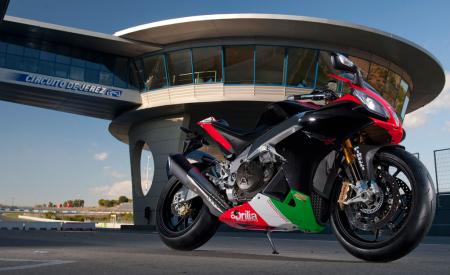 We took to the Circuito De Jerez to test out Aprilia’s exciting RSV4 Factory APRC SE. We took to the Circuito De Jerez to test out Aprilia’s exciting RSV4 Factory APRC SE. |
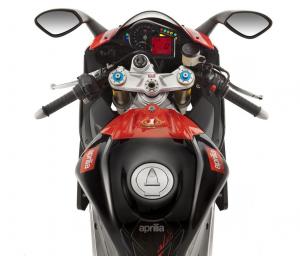
Having followed this bike from the pre-concept stage to reality, I’m delighted to be able to give unconditional praise.
The RSV4 Factory APRC can be called a motorcycling virtuoso in the technical area. A combined (but competitive) effort from Aprilia, BMW and Ducati has bloodied the Japanese noses seriously in the last couple of years. Aprilia and Ducati have done it on the World Superbike circuits and BMW on the sales charts.
Now, let me tell you how good this bike is. On my very first lap the Aprilia technicians force-fed us level eight on the traction control. I thought; “how dull they are ruining my fun like this!” However they were right and I was wrong as this was the perfect way for me to ride the tightest Jerez corners using first gear, full throttle and just let the traction control automate me through the corners.
Without traction control such behaviour on your warm-up lap would end in tears guaranteed. After that I simply used the Mana (absolutely no reference whatsoever to anything else on that bike I promise) switch gear using the minus button to reach lower levels on the traction control or the plus button to go back up. A rider’s left index finger toggles the minus button, and a left thumb for the plus button which is intuitive, all while on the move.
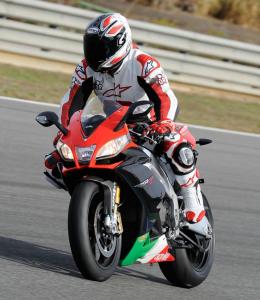
There’s no sound or chugging or anything when the traction control kicks in. I could feel when the rear tire slipped but trusted the ATC instantly. The amount of rear wheelspin allowed is pre-determined depending on which TC level you choose. I worked my way all the way down to level one but I did a whole session using level four which suited me just fine.
Each of us had five sessions on the bike of which the first was to test traction control alone, second session to test wheelie control with traction control, third session to test launch control and the two last sessions to freely explore. That’s nearly two full hours of hardcore undiluted adrenaline pumping action.
Aprilia’s wheelie control is highly sophisticated and not only stops wheelies from happening between low-gear corners but it knows how much it should allow and how to land them soft to avoid upsetting the handling. Don’t you tell me that’s not very clever! The physicality of trying to curb a wheelie while racing is immense. Riders have to use their upper bodies like athletes forcing weight forward while accelerating and withstanding G-forces and wind resistance. Aprilia have with the AWC taken that physicality away, allowing the rider to concentrate on pinning the throttle.
The AWC has three levels to choose from, where I suspect level one is the only race one. Some front wheel lift is always allowed because as long as the wheelie isn’t too high you can still be at maximum acceleration levels. What’s really good about this from a racer’s perspective is to keep that front down between really quick directional changes in low gears while keeping the throttle wide open. A small wheelie is then accepted while you pin it and turn the bike over from side to side, landing it just in time to steer out of the next corner. And landing it smoothly to avoid upsetting the front more than the steering damper can handle. There’s gyrometer wizardry involved here, and not only sensors between the two wheels.
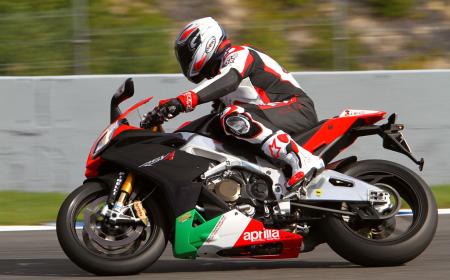 You can bet there’s a big smile hidden behind that tinted visor as he whips this high-tech rocket around Jerez. You can bet there’s a big smile hidden behind that tinted visor as he whips this high-tech rocket around Jerez. |
Torque is the joy and the misery of motorcycling. Too little is dull and slow, while too much in the wrong place can be dangerous. Aprilia has nearly 100% control of torque with the APRC system. The instrumentation is bi-polar with one race mode and one road mode. In race mode there’s no speed indication and the space is used to show a variety of information related to the APRC instead.
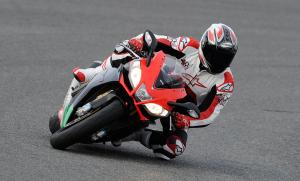
Launch control was another first for me (along with the wheelie control) and the one that’s quite difficult to get right the first time. It’s not for no reason racers practise launch control despite the fact they have done it a thousand times before. True, all you have to do is to keep the throttle fully open and release the clutch. But you still have to modulate the clutch release and, Aprilia allows three levels of how aggressively you can launch. Level one can put you in a lot of wheelie trouble if the clutch is released too quickly.
Training makes perfect, but my three goes at it were a disappointment as I was a little bit too careful with the clutch. Aprilia made sure to advise that the clutch needed some serious cooling after each launch attempt, so we did a full lap between each launch. Imagine yourself being slowly tortured as 180 wild horses are released at once. This feature is not for road use, as you have to pass 100 mph and third gear before the system cancels itself out. And while in launch mode the traction control doesn’t work.
The Aprilia Quick Shifter allows you to shift up clutch-less while keeping a wide-open throttle. I think you’ll start to see the pattern here now. Every operation apart from braking and shifting down can basically be done with full throttle!
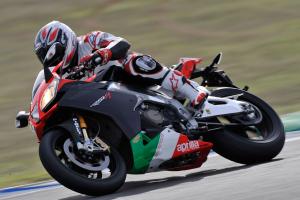 With its closer-spaced gearbox and quick shifter, acceleration is impressive.
With its closer-spaced gearbox and quick shifter, acceleration is impressive.For the Factory APRC Aprilia has added a closer-spaced six-speed gearbox for improved acceleration, plus the quick shifter which makes it into a formidable straight-line dragster.
The Pirelli Supercorsa Diablo SP tires in dimensions 120/70-ZR17 and 200/55-ZR17 were developed in the 2010 FIM Superstock championship. The main advantage with the ultra wide 200-section rear tire is its superb grip on corner exit. The contact patch is wider than ever and provides superb levels of grip when 180 horsepower wants to rip it apart. The tires are approved for speeds up to 198 mph.
More rubber that copes with more heat allows for some very long black lines up turn 4 at Jerez. The only thing that would give you more grip is a full on set of slicks. Wait for it, the RSV4 Factory APRC SE features traction control that self adjusts to new and different tire sizes, also adjusting to different final-drive gearing. There are professional high-end racing teams in the world with less sophisticated electronics than the RSV4 Factory APRC SE road bike.
The suspension consists of fully adjustable top-spec Ohlins items including the steering-damper. The RSV4 Factory has got that subtle but plentiful feel that speaks of high-quality suspension. The Ohlins fork and shock is soft enough for feel in slow corners and hard enough for ultra-fast corners.
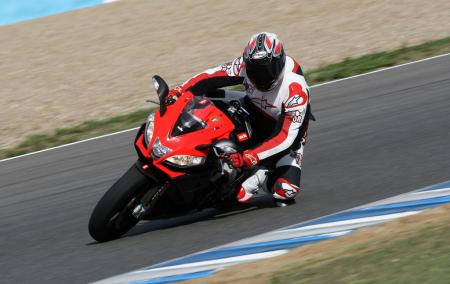 Suspension is all top-notch Ohlins goodies, which is what you should expect in a bike in this price range. Suspension is all top-notch Ohlins goodies, which is what you should expect in a bike in this price range. |
The 999.6cc V-4 engine feature state of the art technology such as independently controlled throttle bodies. Max power is still 180 horsepower at 12,250rpm and 115Nm at 10,000rpm but with improved torque delivery and acceleration in the three lower gears. The new exhaust also helps to improve power delivery.
These changes shoot the RSV4 Factory like a missile out of corners. Only the Ducati 1198 can rival in the corner exit war. The engine feels and sounds great, and for such a powerhouse there’s hardly any vibration. The mechanical slipper clutch helps stopping the bike quickly, and only on two occasions during my day in the saddle could I feel any chatter while hard on the brakes.
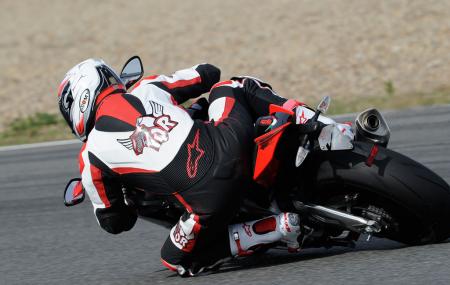 Our tester says this bike exits corners faster than any other liter-sized sportbike. Our tester says this bike exits corners faster than any other liter-sized sportbike. |
If the APRC Special Edition (only 350 to be manufactured) turns out a success (inevitable!) the technology will be fed down to both the RSV4 R and the next RSV4 Factory. Also expect an APRC system drip down to other Aprilia road products where the Dorsoduro 1200 was the first one out.
Conclusion
There are only two things the Aprilia RSV4 Factory APRC SE can’t do, and those are flying and automatically tweet your laptimes. It’s difficult to make sense of this motorcycle on paper, but actually riding it and using the myriad of features on the circuit just immediately tells you that it’s a mechanical and technical genius.
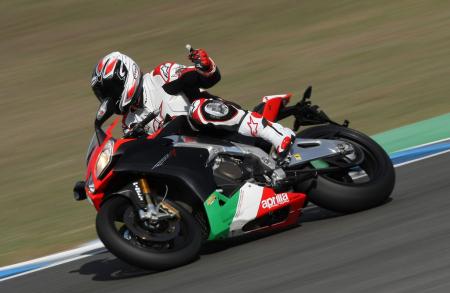 |













